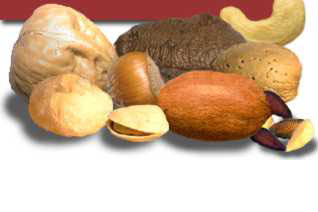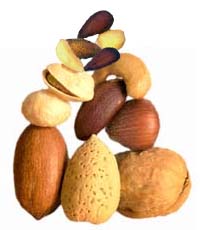

GO NUTS
AND FOLLOW THE NEW 2005 DIETARY GUIDELINES:Advice from the International Tree Nut Council Nutrition Research & Education Foundation
  |
Davis, CA—Just a handful (or 1½ ounces) of tree nuts every day can help you follow the 2005
Dietary Guidelines for Americans. Tree nuts, such as almonds, Brazils, cashews, hazelnuts, macadamias, pecans, pine nuts, pistachios and walnuts, play an important role in healthful eating.As with all foods, portion control is critical. The 2005 Dietary Guidelines focus a great deal on
caloric intake and discretionary calories. While nuts are energy dense, a number of studies have shown an inverse association between frequency of nut consumption and body mass index. “Nuts tend to be filling, which can actually help with weight control,” states Maureen Ternus, M.S., R.D., registered dietitian and Nutrition Coordinator for the International Tree Nut Council Nutrition Research & Education Foundation. “Since tree nuts have such rich and complex flavors, a single 1½-ounce serving is quite satisfying and can easily be eaten as a snack, or enjoyed throughout the day in main dishes or sprinkled on yogurt, salads, soups or pasta.”Chock full of vitamins and minerals, nuts contain many nutrients—vitamin E, calcium,
magnesium, potassium and fiber—that are lacking in the diets of both children and adults in the U.S. Nuts also contain a wide variety of phytochemicals, or plant compounds such as phytosterols (beta-sitosterol), carotenoids, flavonoids and proanthocyanidins, which may help protect against heart disease, cancer and other chronic diseases.The new Dietary Guidelines highlight the DASH Eating Plan and the USDA Food Guide as
examples of recommended eating plans. Nuts play an important role in the DASH diet primarily due to the fact that they are rich sources of energy, magnesium, potassium, protein and fiber.One and one-half ounces of nuts, or 1/3 cup, are recommended 4-5 times per week (as part of the
nuts, seeds and legumes group).The same serving size of nuts is currently recommended by the Food and Drug Administration
(FDA) in one of the first qualified health claims—a claim for nuts and heart disease: “Scientific evidence suggests but does not prove that eating 1.5 ounces per day of most nuts as part of a diet low in saturated fat and cholesterol may reduce the risk of heart disease. [See nutrition information for fat content.]”More than 30 studies have shown that including nuts in the diet can reduce the risk of heart
disease regardless of the individual nut studied. Clearly, nuts can and should play an important role in any healthy diet.As more Americans move toward more plant-based diets, nuts can serve as an important source
of protein. The 2005 Dietary Guidelines recommend that vegetarians of all types substitute 1½ ounces of nuts and 2/3 cup of legumes for 5½ ounces of meat, poultry and/or fish. And, in the USDA Food Guide, ½ ounce of nuts is equivalent to one ounce of meat poultry or fish.-end-

Nutrients in 100 Grams of Tree Nuts and Peanuts¹
|
Nutrient |
Units |
Almonds |
Brazils |
Cashews |
Hazelnuts |
Macadamias |
Peanuts |
Pecans |
Pine nuts |
Pistachios |
Walnuts |
|
Calories |
kcal |
580 |
660 |
570 |
630 |
720 |
590 |
690 |
670 |
570 |
650 |
|
Protein |
g* |
21 |
14 |
15 |
15 |
8 |
24 |
9 |
14 |
21 |
15 |
|
Total Fat |
g |
51 |
66 |
46 |
61 |
76 |
50 |
72 |
68 |
46 |
65 |
|
Saturated Fat (bad) |
g |
4 |
15 |
9 |
4 |
12 |
7 |
6 |
5 |
6 |
6 |
|
Monounsaturated Fat |
g |
32 |
25 |
27 |
46 |
59 |
25 |
41 |
19 |
24 |
9 |
|
Polyunsaturated Fat |
g |
12 |
21 |
8 |
8 |
1.5 |
16 |
22 |
34 |
14 |
47 |
|
Linoleic acid (18:2) |
g |
12 |
20.54 |
7.66 |
7.83 |
1.30 |
16 |
21 |
33 |
13.64 |
38 |
|
Linolenic acid (18:3) |
g |
0 |
0.04 |
0.16 |
0.09 |
0.20 |
0 |
1 |
0.16 |
0.26 |
9 |
|
Cholesterol |
mg** |
0 |
0 |
0 |
0 |
0 |
0 |
0 |
0 |
0 |
0 |
|
Carbohydrate |
g |
20 |
12 |
33 |
17 |
13 |
22 |
14 |
13 |
28 |
14 |
|
Fiber |
g |
12 |
7 |
3 |
10 |
8 |
8 |
10 |
4 |
10 |
7 |
|
Calcium |
mg |
248 |
160 |
45 |
114 |
70 |
54 |
70 |
16 |
110 |
98 |
|
Iron |
mg |
4.30 |
2.43 |
6.00 |
4.70 |
2.65 |
2.26 |
2.53 |
5.53 |
4.20 |
2.91 |
|
Magnesium |
mg |
275 |
376 |
260 |
163 |
118 |
176 |
121 |
251 |
120 |
158 |
|
Phosphorus |
mg |
474 |
725 |
490 |
290 |
198 |
358 |
277 |
575 |
485 |
346 |
|
Potassium |
mg |
728 |
659 |
565 |
680 |
363 |
658 |
410 |
597 |
1,042 |
441 |
|
Sodium |
mg |
1 |
3 |
16 |
0 |
4 |
6 |
0 |
2 |
10 |
2 |
|
Zinc |
mg |
3.36 |
4.06 |
5.60 |
2.45 |
1.29 |
3.31 |
4.53 |
6.45 |
2.30 |
3.09 |
|
Copper |
mg |
1.11 |
1.74 |
2.22 |
1.72 |
0.57 |
0.67 |
1.20 |
32 |
1.32 |
1.59 |
|
Manganese |
mg |
2.53 |
1.22 |
0.83 |
6.17 |
3.04 |
2.08 |
4.50 |
8.80 |
1.27 |
3.41 |
|
Selenium |
mcg*** |
2.80 |
1,917 |
11.70 |
2.40 |
3.60 |
7.50 |
3.80 |
0.70 |
9.30 |
4.90 |
|
Vitamin C |
mg |
0 |
0.70 |
0 |
6.30 |
0.70 |
0 |
1.10 |
0.80 |
2.30 |
1.30 |
|
Thiamin |
mg |
0.24 |
0.62 |
0.20 |
0.64 |
0.71 |
0.44 |
0.66 |
0.36 |
0.84 |
0.34 |
|
Riboflavin |
mg |
0.81 |
0.03 |
0.20 |
0.11 |
0.09 |
0.10 |
0.13 |
0.23 |
0.16 |
0.15 |
|
Niacin |
mg |
3.92 |
0.30 |
1.40 |
1.80 |
2.27 |
13.52 |
1.17 |
4.39 |
1.42 |
1.12 |
|
Pantothenic acid |
mg |
0.35 |
0.18 |
1.22 |
0.92 |
0.60 |
1.39 |
0.86 |
0.31 |
0.51 |
0.57 |
|
Vitamin B6 |
mg |
0.13 |
0.10 |
0.26 |
0.56 |
0.36 |
0.26 |
0.21 |
0.09 |
1.27 |
0.54 |
|
Folate |
mcg |
29 |
22 |
69 |
113 |
10 |
145 |
22 |
67 |
50 |
98 |
|
Vitamin B12 |
mcg |
0 |
0 |
0 |
0 |
0 |
0 |
0 |
0 |
0 |
0 |
|
Vitamin A |
IU**** |
5 |
0 |
0 |
20 |
0 |
0 |
56 |
29 |
262 |
20 |
Vitamin K |
mcg |
0 |
0 |
34.70 |
14.20 |
n/a |
0 |
3.50 |
53.90 |
13.20 |
2.70 |
Vitamin E |
|||||||||||
|
Tocopherol, alpha |
mg |
25.87 |
5.73 |
0.92 |
15.03 |
0.57 |
6.93 |
1.40 |
9.33 |
1.93 |
0.70 |
|
Tocopherol, beta |
mg |
0.43 |
0 |
n/a |
0.33 |
0 |
n/a |
0.39 |
0 |
0.14 |
0.15 |
|
Tocopherol, gamma |
mg |
0.89 |
7.87 |
n/a |
0 |
0 |
n/a |
24.44 |
11.15 |
22.45 |
20.83 |
|
Tocopherol, delta |
mg |
0.25 |
0.77 |
n/a |
0 |
0 |
n/a |
0.47 |
0 |
0.73 |
1.89 |
Total Phytosterols |
mg |
120 |
n/a |
158 |
96 |
114 |
n/a |
102 |
141 |
214 |
72 |
|
Stigmasterol |
mg |
4 |
n/a |
n/a |
1 |
0 |
n/a |
3 |
n/a |
4 |
1 |
|
Campesterol |
mg |
5 |
n/a |
n/a |
6 |
7 |
n/a |
5 |
n/a |
10 |
7 |
|
Beta-sitosterol |
mg |
111 |
n/a |
n/a |
89 |
107 |
n/a |
89 |
n/a |
199 |
64 |
Carotenoids |
|||||||||||
Carotene, beta |
mcg |
3 |
0 |
0 |
11 |
0 |
0 |
29 |
17 |
157 |
12 |
Carotene, alpha |
mcg |
0 |
0 |
0 |
3 |
0 |
0 |
0 |
0 |
0 |
0 |
Cryptoxanthin, beta |
mcg |
0 |
0 |
0 |
0 |
n/a |
0 |
9 |
0 |
0 |
0 |
Lutein + zeaxanthin |
mcg |
1 |
0 |
23 |
92 |
n/a |
0 |
17 |
9 |
1,205 |
9 |
Source: USDA National
Nutrient Database for Standard Reference, Release 16, 2003.
*g = gram; **mg = milligram; ***mcg = microgram; ****IU = International Units
¹All of the nuts are unsalted; almonds, brazilnuts, hazelnuts, pecans, pine
nuts and walnuts are unroasted; cashews, macadamias, peanuts and pistachios are
dry roasted.
Prepared by the International Tree Nut Council Nutrition Research &
Education Foundation, 9/03.
For more information please visit website at www.nuthealth.org.

作者:駐法科技組 現職:駐法科技組
文章來源:CORDIS Wire 2005-05-09發佈時間:94.07.04
堅果(tree nut)和預防心血管疾病之間的關聯受到廣泛研究的注意。初期的研究證明了多吃堅果和預防心肌梗塞或心絞痛之間的關係。